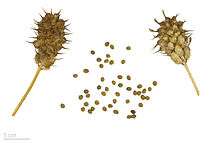Trigonella caerulea
Trigonella caerulea (blue fenugreek,[2][3] blue melilot, Georgian: ულუმბო, უცხო სუნელი - ulumbo, utskho suneli)[4] is an annual herb in the family Fabaceae. It is 30–60 cm tall. Its leaves are obovate or lance-shaped, 2–5 cm long, 1–2 cm wide and saw-toothed in upper part. Its flower stalks are compact, globular racemes, longer than the leaves. The sepals are twice as short as the corolla, its teeth are equal to the tube. The corolla is 5.5-6.5 mm long and blue. The pods are erect or slightly curved, compressed, 4–5 mm long with beak 2 mm. The seeds are small and elongated. It blossoms in April–May, the seeds ripen in May–June. It is self-pollinated.[5]
| Blue fenugreek | |
|---|---|
 | |
| Scientific classification | |
| Kingdom: | Plantae |
| Clade: | Tracheophytes |
| Clade: | Angiosperms |
| Clade: | Eudicots |
| Clade: | Rosids |
| Order: | Fabales |
| Family: | Fabaceae |
| Genus: | Trigonella |
| Species: | T. caerulea |
| Binomial name | |
| Trigonella caerulea | |

Use
Blue fenugreek is widely used in Georgian cuisine, where it is known as utskho suneli.[4] It is one of the ingredients of the Georgian spice mix khmeli suneli.[6] Both the seeds, the pods and the leaves are used. The smell and taste are similar to ordinary fenugreek, but milder.[7] In Switzerland it is used for flavouring the traditional schabziger cheese.[8]
References
- "Trigonella caerulea". Germplasm Resources Information Network (GRIN). Agricultural Research Service (ARS), United States Department of Agriculture (USDA). Retrieved 2013-07-29.
- "Trigonella caerulea". Natural Resources Conservation Service PLANTS Database. USDA. Retrieved 15 December 2015.
- "Trigonella caerulea (L.) Ser. "Blue Fenugreek"". Botanical Society of Britain and Ireland. Retrieved 2019-12-15.
- Rodov V., Vinokur Y., Gogia N., Chkhikvishvili I.D. (2010). "Hydrophilic and lipophilic antioxidant capacities of Georgian spices for meat and their possible health implication" (PDF). Georgian Medical News. 179 (2): 61–66.CS1 maint: uses authors parameter (link))
- AgroAtlas, accessed 29 July 2013.
- Darra Goldstein (1999). The Georgian feast: the vibrant culture and savory food of the Republic of Georgia. University of California Press. p. 44. ISBN 0-520-21929-5.
- Blue fenugreek, Gernot Katzer's spice dictionary
- Kräuter und Gewürze aus heimischem Anbau (in German)